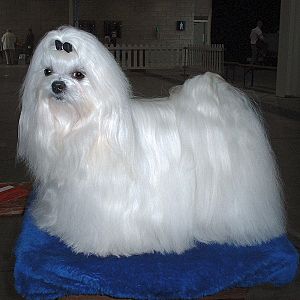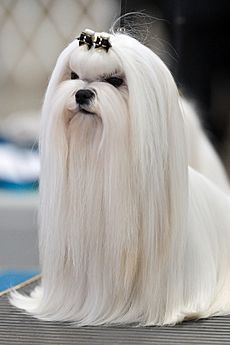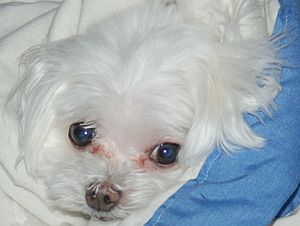Maltese dog facts for kids

Maltese groomed with overcoat
|
|||||||||||||||||||||||||||||
| Origin | Central Mediterranean Region | ||||||||||||||||||||||||||||
|---|---|---|---|---|---|---|---|---|---|---|---|---|---|---|---|---|---|---|---|---|---|---|---|---|---|---|---|---|---|
|
|||||||||||||||||||||||||||||
|
|||||||||||||||||||||||||||||
| Domestic dog (Canis lupus familiaris) | |||||||||||||||||||||||||||||
The Maltese is a breed of dog in the toy group. It is thought to have originated in south-central Europe from dogs of spitz type. Despite the name, it has no verified historic or scientific connection to the island of Malta.
Contents
History
The FCI adopted the Maltese breed standard under the patronage of Italy in 1954, at the annual meeting in Interlaken, Switzerland. The American Kennel Club recognized the breed in 1888, its latest standard being from March 10, 1964. Parti-colour and solid colour dogs were accepted in the show ring from 1902 until 1913 in England, and as late as 1950 in Victoria, Australia. However, white Maltese were required to be pure white. Coloured Maltese could be obtained from the south of France.
Little is known about the origin and spread of the Maltese dog. It probably did not originate from the island of Malta, the town of Melita in Italy, nor the island of Melita in the Adriatic, but from spitz-type dogs in south-central Europe, where it may at first have resembled the modern Pomeranian.
Melitaie
The Maltese dog was a lapdog favoured by both the ancient Greeks and Romans, especially their children, and appears on amphorae with the word Μελιταίε (Melitaie). References to the dog can also be found in Ancient Greek and Roman literature. Aristotle mentions the dog around 370 BC. Early writers attribute its origin to Melita, however there were two islands named Melita at that time with one being in the Mediterranean and the other being in the Adriatic sea near Dalmatia, which confuses where the dog originated from. Strabo wrote about the Canes Melitei that came not from Malta but from a town named Melita in Sicily, which is in contrast to English writers who give Malta as the place of origin, considering that Melite is also the old name of Mdina, former capital of Malta.
Pliny suggests the dog as having taken its name from the Adriatic island Méléda, however Strabo, in the early first century AD, identifies the breed as originating from the Mediterranean island of Malta.
During the first century, the Roman poet Martial wrote descriptive verses to a lap dog named "Issa" owned by his friend Publius. It is proposed that Issa was a Maltese dog, and various sources link Martial's friend Publius with the Roman Governor Publius of Malta, though others do not identify him.
John Caius, physician to Queen Elizabeth I, also claimed that Callimachus was referring to the island of Melita "in the Sicilian strait" (Malta). This claim is often repeated, especially by English writers. The dog's links to Malta are mentioned in the writings of Abbé Jean Quintin, Secretary to the Grand Master of the Knights of Malta Philippe Villiers de L'Isle-Adam, in his work Insulae Melitae Descriptio.
Description
Appearance
Characteristics include slightly rounded skulls, with a finger-wide dome, a black button nose and brown eyes. The body is compact with the length equaling the height and the tail is almost always curled. The drop ears with (sometimes) long hair, and eyes surrounded by darker skin pigmentation (called a "halo"), gives Maltese their expressive look. Lacking exposure to a lot of sunlight, their noses can fade and become pink or light brown in color. This is often referred to as a "winter nose" and many times will become black again with increased exposure to the sun. The Maltese's paws are very sensitive to touch.
The coat is dense, glossy, silky and shiny, falling heavily along the body without curls or an undercoat. The colour is pure white, however a pale ivory tinge is permitted.
The Maltese does not shed, and is therefore a good choice for people with dog allergies. They can exhibit signs of tear-staining. Tear stains can be caused by health issues, blocked tear-ducts, or allergies. They can be removed through tear stain wipes, soft chews, and formula that can be placed in their food or water. Tear staining happens on other breeds as well, but it is more prevalent in the Maltese breed because their coat is white. Some people prefer their dogs to have the coat short, clipped to a few centimeters in length.
Adult Maltese tend to weigh 3–4 kg (6.6–8.8 lb).
Uses
The Maltese is kept for companionship, for ornament, or for showing. It is ranked 59th of 79 breeds assessed for intelligence by Stanley Coren.
See also
 In Spanish: Bichón maltés para niños
In Spanish: Bichón maltés para niños



